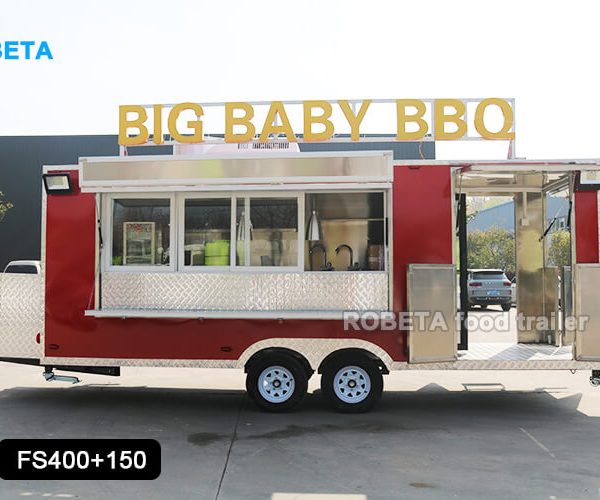
To attract more customers to your food trailers in 2025, focus on enhancing the customer experience through personalization, convenience, and social responsibility, while leveraging technology to improve efficiency and engagement. This article will explore some key strategies and tips to help your gourmet trailer business thrive in a competitive market.

1. Develop a Unique Selling Proposition (USP)
A unique selling proposition is the key to making your food truck stand out from the competition. To create an effective USP, follow these steps:
Understand the value of your target market
Understanding your target market is the foundation for building a strong USP. Conduct research, engage with customers on social media, and analyze competitors to determine what your audience values most. Is it speed, affordability, food quality, or dietary inclusivity? Customize your offerings based on these preferences.
Determine the unique features of your product or service
After understanding your target market, determine what makes your product or service unique. What makes your food trailer so special? It could be a signature dish, unique ingredients, or a unique cooking method. Focus on what makes you different or superior to your competitors.
Make your unique selling proposition clear and concise
Your USP should be easy to understand and communicate. Avoid jargon or overly complex statements. For example, instead of saying, “We serve globally flavored artisanal dishes made with local, high-quality ingredients,” say, “Strong international flavors, locally sourced ingredients. Make the USP description memorable and compelling.
Quality Check
Make sure your Unique Selling Point (USP) resonates with your audience and accurately reflects your product/service. Test your Unique Selling Point with focus groups or trusted customers. Their feedback can help you refine your Unique Selling Proposition and make it more appealing.
Test and modify your unique selling proposition
USPs are not set in stone. As market trends and customer preferences evolve, so should your proposition. Review your USP regularly and test its effectiveness through customer surveys, sales data, and social media interactions. Make adjustments as needed to stay current.
2. Prioritize food quality and consistency
While a great brand image can attract customers, it’s the dishes that really keep them coming back. Focus on consistently delivering high-quality dishes. Here are some suggestions:
– Use fresh, high-quality ingredients.
– Standardize recipes to ensure consistency.
– Seek regular customer feedback to improve your product.
Remember, word of mouth is still one of the most powerful marketing tools. Satisfied customers are more likely to recommend your food truck to others.
3. Optimize your menu
A well-designed menu is critical to the success of your food truck. It’s not just about the dishes you serve; the menu not only sets the tone of your brand, it also defines the dining experience for your customers. But where do you start?
First, consider the market you’re entering and look at what other food trucks are offering. Unless you have a truly unique dish, you don’t want to flood the dining market with one-size-fits-all dishes. Instead, you should focus on a niche market and think about some specialties that will define your food truck’s character.
Also, when planning your menu, consider which ingredients can be used in different dishes. Not only will this make your menu more cohesive, but it will also streamline operational processes and keep costs in check. For small food truck kitchens, efficiency is critical. Customers expect fast service, so your menu should be concise and efficient to meet that need.
Finally, consider the cost-effectiveness of your ingredients and whether simplifying your dishes will save you money without sacrificing quality. Not only is a streamlined menu easier to manage, it will also help you to make each dish perfect, ensuring that customers receive a high-quality dining experience.
4. Focus on branding
Your food truck’s branding plays a critical role in attracting customers. Consider the following elements:
– Trailer design:
invest in creating compelling trailer visuals. Bold colors, fun graphics, and clear menu boards will grab your audience’s attention from afar.
– Social media reach:
platforms like Instagram and TikTok are great for showcasing your food and engaging with customers. You can post high-quality photos, behind-the-scenes footage, and updates on your restaurant’s location or menu.
– Memorable name:
Choose a name that is easy to remember and reflects your food and personality.
5. Provide excellent customer service
Exceptional customer service is what makes your business stand out. Train your staff to be friendly, efficient, and familiar with the menu. Answer customer questions promptly and sincerely. Positive interactions can turn one-time customers into loyal ones. Resolve any customer concerns or complaints in a timely manner to foster loyalty and build goodwill.
Conclusion
The food truck industry is highly competitive, but with planning, creativity, and all-out effort, you can stand out. Focus on unique selling points, branding, quality, and maintaining good customer relations, and your food trailer can grow steadily even in a fierce market.
FAQs
Where do food trucks make the most money?
Food trucks tend to make the most money in areas with high foot traffic and concentrations of potential customers, such as major cities, near events like concerts or festivals, and in business districts during lunch hours. New York City, for example, has the highest median food truck revenue.
How much do food truck owners typically make per year?
Food truck owners can make anywhere from $24,000 to $153,000 annually, but their salaries are typically less than 50% of the truck’s profits after expenses are covered, according to the Auguste Escoffier School of Culinary Arts. The wide range in income depends on various factors, including location, menu, and operating hours, says The Restaurant Store.
What is the future outlook for food trucks?
The future of food trucks looks promising, with continued growth and innovation expected in the coming years. The industry is projected to expand with a CAGR of 5% or more. This growth will be fueled by technological advancements, diverse culinary offerings, and a focus on sustainability.

